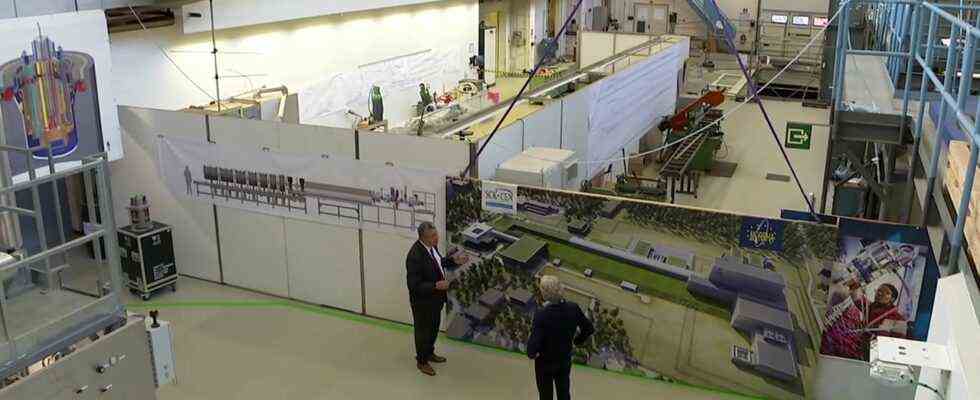European magazine
Status: 04.09.2021 09:02 a.m.
Scientists in a research reactor in Belgium are confident: they believe they have found a solution to the nuclear waste problem. A particle accelerator is at the center of her work.
It is an area that cannot be shown for security reasons: the Belgian atomic research facility Myrrha is located around 70 kilometers north-west of Brussels in the small village of Mol, the area is fenced off with barbed wire.
In the area, however, the reception is very open. The director of the facility, Hamid Ait Abderrahm, likes to show the European research and showcase project, because here they want to solve nothing less than a great human problem: “We have nuclear waste on the table for the next 300,000 years, and our job is to find solutions. We call it transmutation! “
This is how it works: Protons are shot into a particle accelerator, where they develop a tremendous speed, and in a nuclear reactor neutrons then fire the long-lived nuclear waste and break it down into less dangerous components. In this way, according to Abderrahm, “we are shortening the underground storage time from 300,000 years to 300, that is by a factor of 1000. And we are also reducing the amount – by a hundredfold.”
Belgium: solution to the spent fuel problem?
Michael Grytz, ARD Brussels, Europamagzin, 3.9.2021
Solution to an old problem?
Researchers have been working on the technology for decades. Now they think it might actually work. To get rid of the nuclear waste you need new nuclear reactors. Different than usual. The researchers say this type of reactor is safe. Abderrahm explains it this way: “In a fraction of a second after we shut down the particle accelerator, the reactor shuts down because it does not contain enough fissile material. And this particle accelerator is the fundamental part of ensuring the safety of the reactor.”
“Politically charged topic”
This particle accelerator, which is primarily intended to make the facility safe, is still in the Louvain La Neuve University. The scientists at the University of Applied Physics in Frankfurt am Main are specialists in this field.
Klaus Kümpel continues the decades of research together with others. Now they are ready – almost at least. “That cannot be described,” says Kümpel, referring to the years of work, the importance of the project and the breadth of cooperation across Europe. “It is really something special when you can see that it can work”.
But he also knows that there are other difficulties in addition to the technical challenges: “We are aware that the subject is politically charged and that there is no public acceptance. Nevertheless, research should always be possible.”
The interim and final storage of nuclear waste is a problem worldwide – here containers from Great Britain arrive in Biblis in Hesse.
Image: dpa
A means against climate change?
But with myrrha there is actually a chance to get rid of substantial parts of the nuclear waste. Even more: the reactor even generates electricity, explains the director. Unsurprisingly, he also wants to use atomic energy in the fight against climate change: “A combination of renewable energies and nuclear energy is a rational answer to the challenges posed by climate change.”
In fact, not only in Europe, many countries continue to rely on nuclear energy – above all France and some Eastern European countries. Some reactors are to be built or are being planned. There is a dispute in the EU over the question of whether old and new nuclear energy can also be a means against climate change, as part of the so-called Green Deal. And whether it should also be financed with European funds.
Some countries are “very anti-nuclear”
At the EU summit in December 2019, French President Emmanuel Macron made it clear: “France makes 60 percent of its energy from nuclear power. For other countries with coal energy it is clear that they cannot switch to renewables overnight, that is impossible.”
But Macron also registered that some countries are “very anti-nuclear” and referred straight away to Austria and Luxembourg, which did not want nuclear energy to be linked to climate neutrality.
How much EU money for nuclear power?
The dispute is simmering, and President Macron recently demanded, together with Hungary and Poland, among others, that nuclear energy should not only be recognized, but also promoted. It is possible that European money will soon end up in the construction of nuclear facilities.
EU money has already flowed into the European research project in Mol. It should be 1.6 billion euros in total. Far too much, say critics. Especially since it is not yet clear whether the project will work. But in the coming year, the construction of the real plant is to begin. It could then be so far in 2030. And maybe then there will be an opportunity right here to reduce nuclear waste, which no one knows what to do with it so far.
You can see these and other reports in Europamagazin – on Sunday at 12.45 p.m. in Das Erste.

